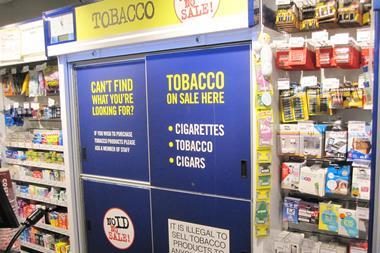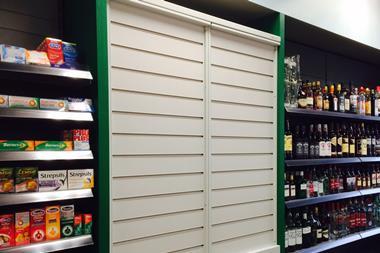C-Store recently welcomed a panel of leading retailers to a seminar jointly hosted by leading cigar manufacturer Scandinavian Tobacco
With less than two months to go until the tobacco display ban on April 6, there are growing concerns that a significant number of small store retailers are still not ready. In fact, as recently as November a poll of Convenience Store readers revealed that 45% of retailers had still not finalised a display ban solution.
Retailer Paul Cheema said: “I have three stores and all of the gantries are being converted by one of the major tobacco companies – however, they were incorrectly measured and all of the frames are currently the wrong size! I am confident that this will be sorted well before the ban comes into force, though. I’m less confident about staff training, however, as it’s only very recently that the information and advice on what you can and cannot do has started to filter through. A robust staff training plan is crucial, especially for a retailer such as myself who has three stores and more than 30 members of staff.”
Londis retailer and STG UK Gantry Guardian Raj Aggarwal added: “I’m having sliding doors fitted to one of my store gantries by one of the manufacturers, but in the other store I’ve still not made my mind up. I’m currently considering a different kind of solution in conjunction with a major UK drinks supplier, which would split the gantry in two so that tobacco is hidden by doors at the bottom, while high-value alcoholic drinks are merchandised above.
“This solution would require me to reduce my tobacco range, but that doesn’t bother me too much as in a recent analysis of my epos data I discovered that 48% of my sales came from just 12 SKUs.”
The retailers agreed that symbol groups had been slow to offer advice and guidance, and that more should have been done to filter information to store owners via business development managers.
James Higgs from STG UK suggested that a range of different compliance solutions would be helpful for the industry. “A tobacco range is so personal and varies dramatically from store to store, based on the local demographic and needs. Every store is different, just as every customer is. That’s why, in my experience, it’s helpful to have a variety of solutions to suit all the different store formats.”
LARGE STORE LEARNINGS
West Sussex Budgens retailer David Knight has been trading with a covered gantry since 2012 and was able to give retailers the benefit of his experience. He admitted to being worried about the ban before it came into force.
“Tobacco accounts for only 4.7% of my sales, which isn’t huge, but they drive associated purchases of things such as confectionery and soft drinks, so I was concerned about the impact on those sales,” he explained.
“The gantries got measured and tracks for sliding doors were fitted, but after that there was a bit of a lull and very little communication or advice about staff training, which was a major concern of mine. In the end I invited our local Trading Standards team to come in and go through the legislation with us. I then wrote my own staff training paper and asked them to validate it, which they did.
“Building up that relationship with them prior to the ban was important to me and we actually got a huge amount out of Trading Standards so I’m really glad we did that – especially as the past three visits that we’ve had from them since have been primarily focusing on tobacco rather than pricing or anything else.”
The first major problem he experienced in Hassocks was that shoppers were confused by the covers, and in some cases angry.
“As there had been next to no communication about the ban from the Department of Health, many customers didn’t believe that the ban was a genuine legal requirement,” he said. “They thought that it was my policy, and I received a number of letters of complaint. People even wrote to Budgens’ Head Office complaining about me! With hindsight I should have done much more myself to communicate the change to shoppers. We made the mistake of focusing wholly on internal compliance and forgot the shopper entirely, which is a cardinal sin for a convenience store.
“Confused shoppers also led to significant delays at the till as staff had to spend time explaining what had happened to angry adult smokers. In the end we had to ensure that all three tills were continuously manned, even at quieter times of the day, to try to mitigate the queues. My advice to all retailers is start telling your shoppers now, learn from my mistake, and don’t leave it till the last minute. There are lots of things you could do, from simply telling each tobacco shopper what’s coming up, to using in-store posters and POS material to say that a change is coming.”
David recalled that availability also became an unforeseen, but significant, problem. “At first we kept on running out of stock,” he said. “Once the staff and managers couldn’t see the tobacco, they just forgot about it. One Sunday afternoon when we were closed I happened to open up the gantry and I was horrified to find it almost completely empty. It turned out that staff had forgot to replenish it, or even place a new order for two days. I then found out that customers had been queuing for five minutes at the till, only to be told that what they wanted wasn’t available.
“It took us about four months to figure out how to rework the gantry. In the end we introduced a very strict mandate on gap checks, with availability checked every two hours.”
Gantry price labels presented another challenge, David added. “The legislation states that all price labels need to be no larger than 9sq cm, which is much smaller than before and not a standard size. We were able to shrink our labels down but not all systems will be able to, so I’d advise retailers to start looking at this now.”
STG UK’s James Higgs echoed the wisdom of building a relationship with local enforcement authorities.
“As retailers, your relationship with Trading Standards is so important,” he said. “You can help them better understand how the convenience market is structured, and that a symbol group store is not the same as a Tesco Express. There is a very real worry that they do not understand the difference and that symbol group retailers are independent businessmen and women who may need their help and support.”
FURTHER INFORMATION
STG UK has a raft of advice available to help small stores ready themselves for the display ban via its ‘Gantry Guardians Guide to Tobacco’.
Two guides have been produced so far and these include advice on key trends as well as tips on how to prepare for the dark market. Both are underpinned by peer-to-peer advice from a panel of leading convenience store owners.
Interested retailers keen to get their hands on the STG UK Gantry Guardians Guides to Tobacco should ask their STG UK sales representative, or contact customer services on 020 8731 3400 or email enquiries.uk@st-group.com.
The Association of Convenience Stores has a comprehensive pictorial guide to the ban as part of its Assured Advice scheme. For more information, visit www.acs.org.uk/advice.


















No comments yet